Report on Business Ventures: Types, Functions, and Objectives
VerifiedAdded on 2023/01/12
|9
|1705
|67
Report
AI Summary
This report provides a detailed analysis of various business ventures, categorizing them into public, private, and voluntary sectors. It explores the legal structures, risk mitigation strategies, and the importance of market share and shareholder responsibility within these organizational frameworks. The report examines the size and scope of different companies, highlighting the impact of public investment and private capital on operational efficiency and market reach. Furthermore, it delves into the relationship between organizational functions, such as marketing, human resources, and production, and how these departments contribute to achieving company objectives. The report emphasizes the significance of interdepartmental cooperation and communication in fostering efficiency, profitability, and sustainable growth. Additionally, it discusses the goals and objectives of each sector and their impact on society and the business environment.

Report on suitable Business
Ventures.
Ventures.
Paraphrase This Document
Need a fresh take? Get an instant paraphrase of this document with our AI Paraphraser

Table of Content
INTRODUCTION...........................................................................................................................1
LO1..................................................................................................................................................1
P1 Types and purposes of various organizations.........................................................................1
P2 The size and scope of different organizations........................................................................2
LO2..................................................................................................................................................3
P3 Organizational functions and their linkage with company objectives....................................3
CONCLUSION................................................................................................................................4
REFRERENCES..............................................................................................................................5
INTRODUCTION...........................................................................................................................1
LO1..................................................................................................................................................1
P1 Types and purposes of various organizations.........................................................................1
P2 The size and scope of different organizations........................................................................2
LO2..................................................................................................................................................3
P3 Organizational functions and their linkage with company objectives....................................3
CONCLUSION................................................................................................................................4
REFRERENCES..............................................................................................................................5
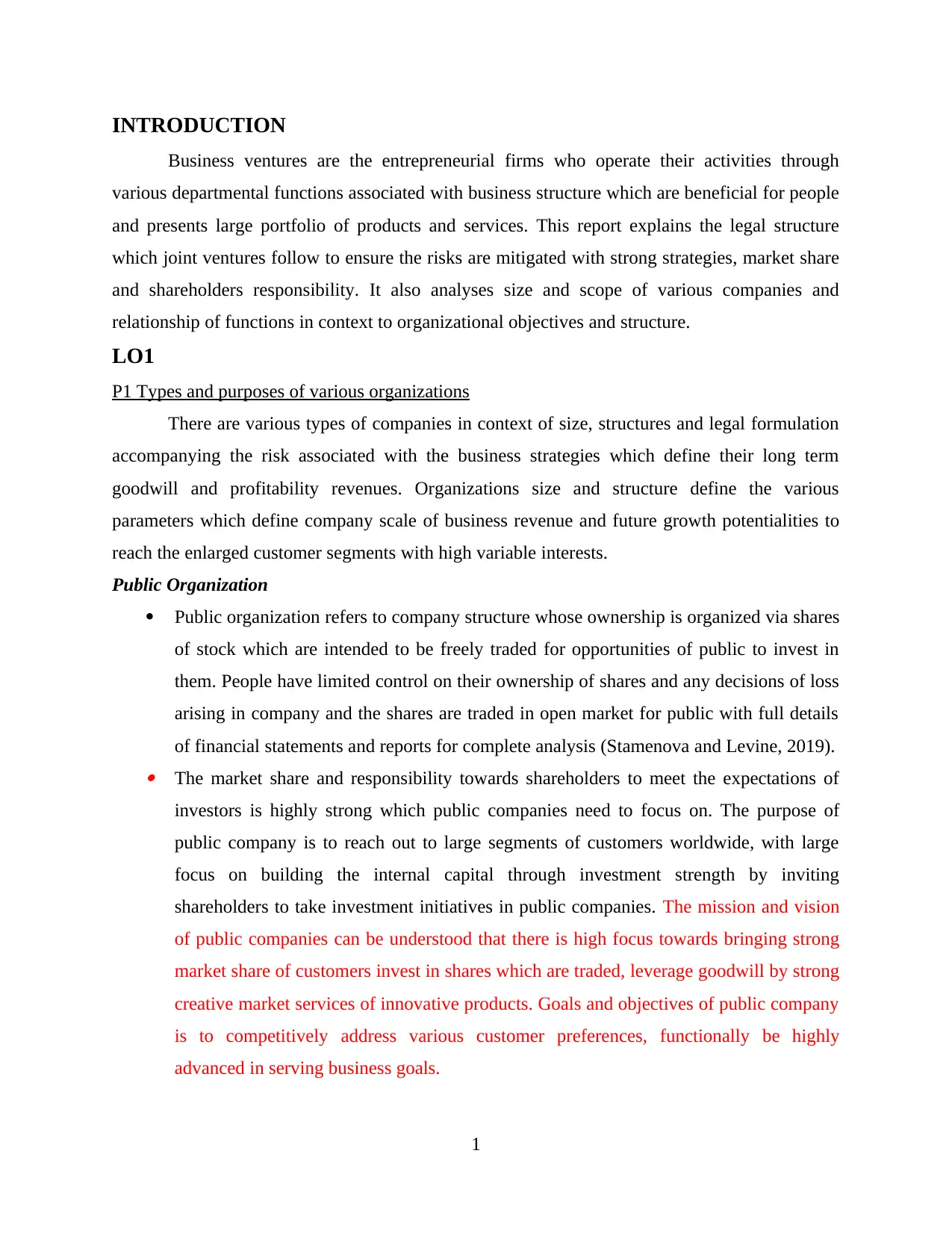
INTRODUCTION
Business ventures are the entrepreneurial firms who operate their activities through
various departmental functions associated with business structure which are beneficial for people
and presents large portfolio of products and services. This report explains the legal structure
which joint ventures follow to ensure the risks are mitigated with strong strategies, market share
and shareholders responsibility. It also analyses size and scope of various companies and
relationship of functions in context to organizational objectives and structure.
LO1
P1 Types and purposes of various organizations
There are various types of companies in context of size, structures and legal formulation
accompanying the risk associated with the business strategies which define their long term
goodwill and profitability revenues. Organizations size and structure define the various
parameters which define company scale of business revenue and future growth potentialities to
reach the enlarged customer segments with high variable interests.
Public Organization
Public organization refers to company structure whose ownership is organized via shares
of stock which are intended to be freely traded for opportunities of public to invest in
them. People have limited control on their ownership of shares and any decisions of loss
arising in company and the shares are traded in open market for public with full details
of financial statements and reports for complete analysis (Stamenova and Levine, 2019). The market share and responsibility towards shareholders to meet the expectations of
investors is highly strong which public companies need to focus on. The purpose of
public company is to reach out to large segments of customers worldwide, with large
focus on building the internal capital through investment strength by inviting
shareholders to take investment initiatives in public companies. The mission and vision
of public companies can be understood that there is high focus towards bringing strong
market share of customers invest in shares which are traded, leverage goodwill by strong
creative market services of innovative products. Goals and objectives of public company
is to competitively address various customer preferences, functionally be highly
advanced in serving business goals.
1
Business ventures are the entrepreneurial firms who operate their activities through
various departmental functions associated with business structure which are beneficial for people
and presents large portfolio of products and services. This report explains the legal structure
which joint ventures follow to ensure the risks are mitigated with strong strategies, market share
and shareholders responsibility. It also analyses size and scope of various companies and
relationship of functions in context to organizational objectives and structure.
LO1
P1 Types and purposes of various organizations
There are various types of companies in context of size, structures and legal formulation
accompanying the risk associated with the business strategies which define their long term
goodwill and profitability revenues. Organizations size and structure define the various
parameters which define company scale of business revenue and future growth potentialities to
reach the enlarged customer segments with high variable interests.
Public Organization
Public organization refers to company structure whose ownership is organized via shares
of stock which are intended to be freely traded for opportunities of public to invest in
them. People have limited control on their ownership of shares and any decisions of loss
arising in company and the shares are traded in open market for public with full details
of financial statements and reports for complete analysis (Stamenova and Levine, 2019). The market share and responsibility towards shareholders to meet the expectations of
investors is highly strong which public companies need to focus on. The purpose of
public company is to reach out to large segments of customers worldwide, with large
focus on building the internal capital through investment strength by inviting
shareholders to take investment initiatives in public companies. The mission and vision
of public companies can be understood that there is high focus towards bringing strong
market share of customers invest in shares which are traded, leverage goodwill by strong
creative market services of innovative products. Goals and objectives of public company
is to competitively address various customer preferences, functionally be highly
advanced in serving business goals.
1
⊘ This is a preview!⊘
Do you want full access?
Subscribe today to unlock all pages.

Trusted by 1+ million students worldwide
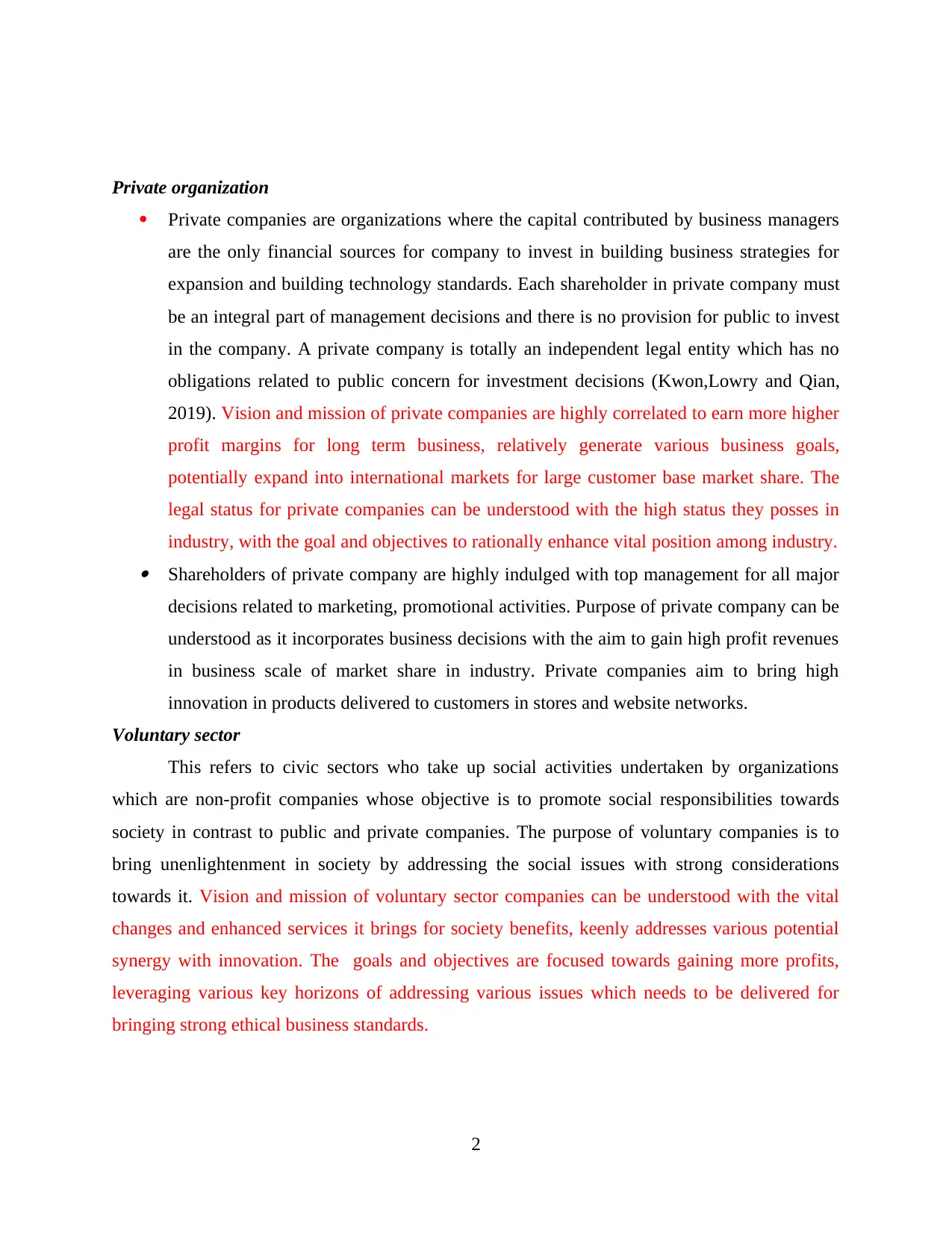
Private organization
Private companies are organizations where the capital contributed by business managers
are the only financial sources for company to invest in building business strategies for
expansion and building technology standards. Each shareholder in private company must
be an integral part of management decisions and there is no provision for public to invest
in the company. A private company is totally an independent legal entity which has no
obligations related to public concern for investment decisions (Kwon,Lowry and Qian,
2019). Vision and mission of private companies are highly correlated to earn more higher
profit margins for long term business, relatively generate various business goals,
potentially expand into international markets for large customer base market share. The
legal status for private companies can be understood with the high status they posses in
industry, with the goal and objectives to rationally enhance vital position among industry. Shareholders of private company are highly indulged with top management for all major
decisions related to marketing, promotional activities. Purpose of private company can be
understood as it incorporates business decisions with the aim to gain high profit revenues
in business scale of market share in industry. Private companies aim to bring high
innovation in products delivered to customers in stores and website networks.
Voluntary sector
This refers to civic sectors who take up social activities undertaken by organizations
which are non-profit companies whose objective is to promote social responsibilities towards
society in contrast to public and private companies. The purpose of voluntary companies is to
bring unenlightenment in society by addressing the social issues with strong considerations
towards it. Vision and mission of voluntary sector companies can be understood with the vital
changes and enhanced services it brings for society benefits, keenly addresses various potential
synergy with innovation. The goals and objectives are focused towards gaining more profits,
leveraging various key horizons of addressing various issues which needs to be delivered for
bringing strong ethical business standards.
2
Private companies are organizations where the capital contributed by business managers
are the only financial sources for company to invest in building business strategies for
expansion and building technology standards. Each shareholder in private company must
be an integral part of management decisions and there is no provision for public to invest
in the company. A private company is totally an independent legal entity which has no
obligations related to public concern for investment decisions (Kwon,Lowry and Qian,
2019). Vision and mission of private companies are highly correlated to earn more higher
profit margins for long term business, relatively generate various business goals,
potentially expand into international markets for large customer base market share. The
legal status for private companies can be understood with the high status they posses in
industry, with the goal and objectives to rationally enhance vital position among industry. Shareholders of private company are highly indulged with top management for all major
decisions related to marketing, promotional activities. Purpose of private company can be
understood as it incorporates business decisions with the aim to gain high profit revenues
in business scale of market share in industry. Private companies aim to bring high
innovation in products delivered to customers in stores and website networks.
Voluntary sector
This refers to civic sectors who take up social activities undertaken by organizations
which are non-profit companies whose objective is to promote social responsibilities towards
society in contrast to public and private companies. The purpose of voluntary companies is to
bring unenlightenment in society by addressing the social issues with strong considerations
towards it. Vision and mission of voluntary sector companies can be understood with the vital
changes and enhanced services it brings for society benefits, keenly addresses various potential
synergy with innovation. The goals and objectives are focused towards gaining more profits,
leveraging various key horizons of addressing various issues which needs to be delivered for
bringing strong ethical business standards.
2
Paraphrase This Document
Need a fresh take? Get an instant paraphrase of this document with our AI Paraphraser
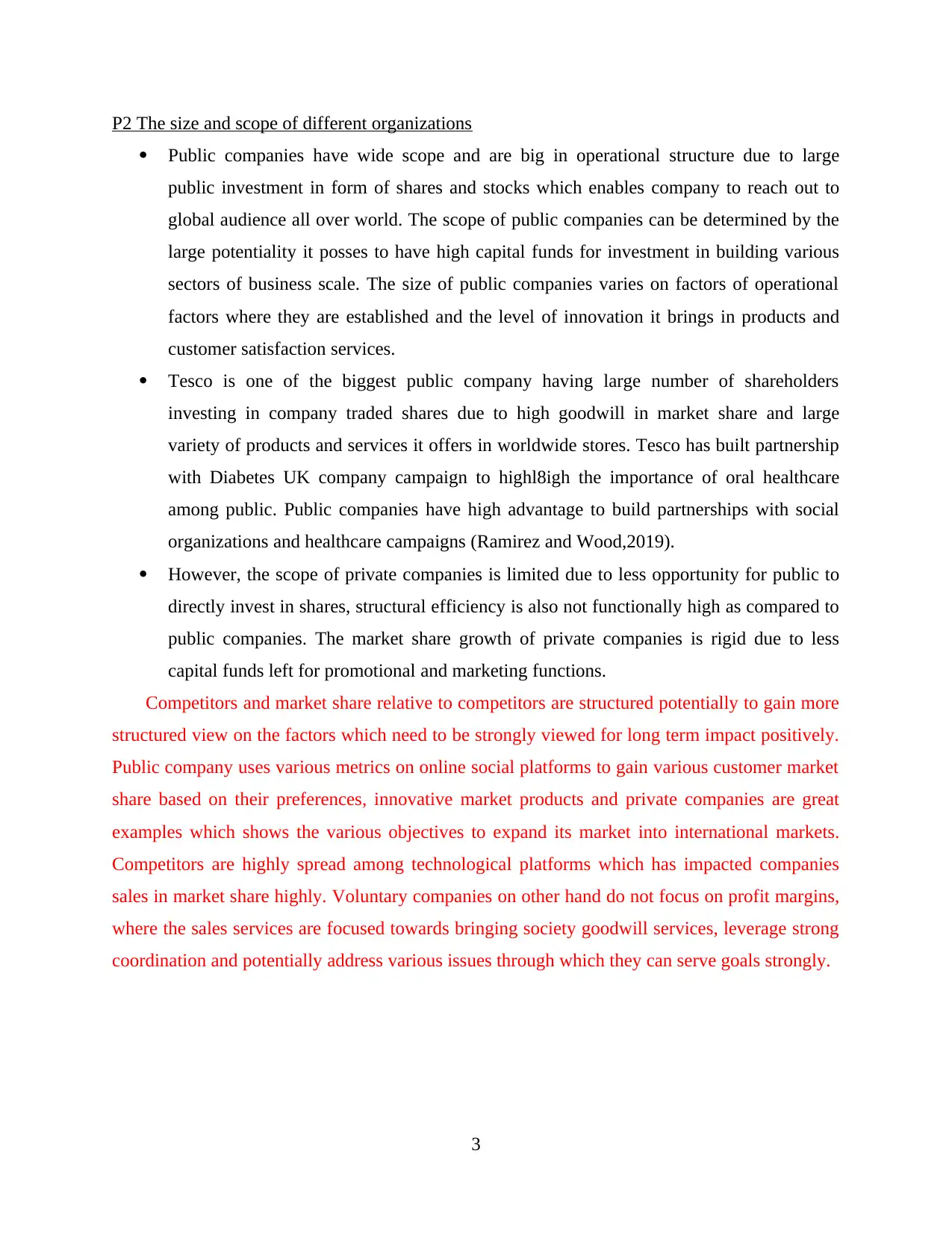
P2 The size and scope of different organizations
Public companies have wide scope and are big in operational structure due to large
public investment in form of shares and stocks which enables company to reach out to
global audience all over world. The scope of public companies can be determined by the
large potentiality it posses to have high capital funds for investment in building various
sectors of business scale. The size of public companies varies on factors of operational
factors where they are established and the level of innovation it brings in products and
customer satisfaction services.
Tesco is one of the biggest public company having large number of shareholders
investing in company traded shares due to high goodwill in market share and large
variety of products and services it offers in worldwide stores. Tesco has built partnership
with Diabetes UK company campaign to highl8igh the importance of oral healthcare
among public. Public companies have high advantage to build partnerships with social
organizations and healthcare campaigns (Ramirez and Wood,2019).
However, the scope of private companies is limited due to less opportunity for public to
directly invest in shares, structural efficiency is also not functionally high as compared to
public companies. The market share growth of private companies is rigid due to less
capital funds left for promotional and marketing functions.
Competitors and market share relative to competitors are structured potentially to gain more
structured view on the factors which need to be strongly viewed for long term impact positively.
Public company uses various metrics on online social platforms to gain various customer market
share based on their preferences, innovative market products and private companies are great
examples which shows the various objectives to expand its market into international markets.
Competitors are highly spread among technological platforms which has impacted companies
sales in market share highly. Voluntary companies on other hand do not focus on profit margins,
where the sales services are focused towards bringing society goodwill services, leverage strong
coordination and potentially address various issues through which they can serve goals strongly.
3
Public companies have wide scope and are big in operational structure due to large
public investment in form of shares and stocks which enables company to reach out to
global audience all over world. The scope of public companies can be determined by the
large potentiality it posses to have high capital funds for investment in building various
sectors of business scale. The size of public companies varies on factors of operational
factors where they are established and the level of innovation it brings in products and
customer satisfaction services.
Tesco is one of the biggest public company having large number of shareholders
investing in company traded shares due to high goodwill in market share and large
variety of products and services it offers in worldwide stores. Tesco has built partnership
with Diabetes UK company campaign to highl8igh the importance of oral healthcare
among public. Public companies have high advantage to build partnerships with social
organizations and healthcare campaigns (Ramirez and Wood,2019).
However, the scope of private companies is limited due to less opportunity for public to
directly invest in shares, structural efficiency is also not functionally high as compared to
public companies. The market share growth of private companies is rigid due to less
capital funds left for promotional and marketing functions.
Competitors and market share relative to competitors are structured potentially to gain more
structured view on the factors which need to be strongly viewed for long term impact positively.
Public company uses various metrics on online social platforms to gain various customer market
share based on their preferences, innovative market products and private companies are great
examples which shows the various objectives to expand its market into international markets.
Competitors are highly spread among technological platforms which has impacted companies
sales in market share highly. Voluntary companies on other hand do not focus on profit margins,
where the sales services are focused towards bringing society goodwill services, leverage strong
coordination and potentially address various issues through which they can serve goals strongly.
3
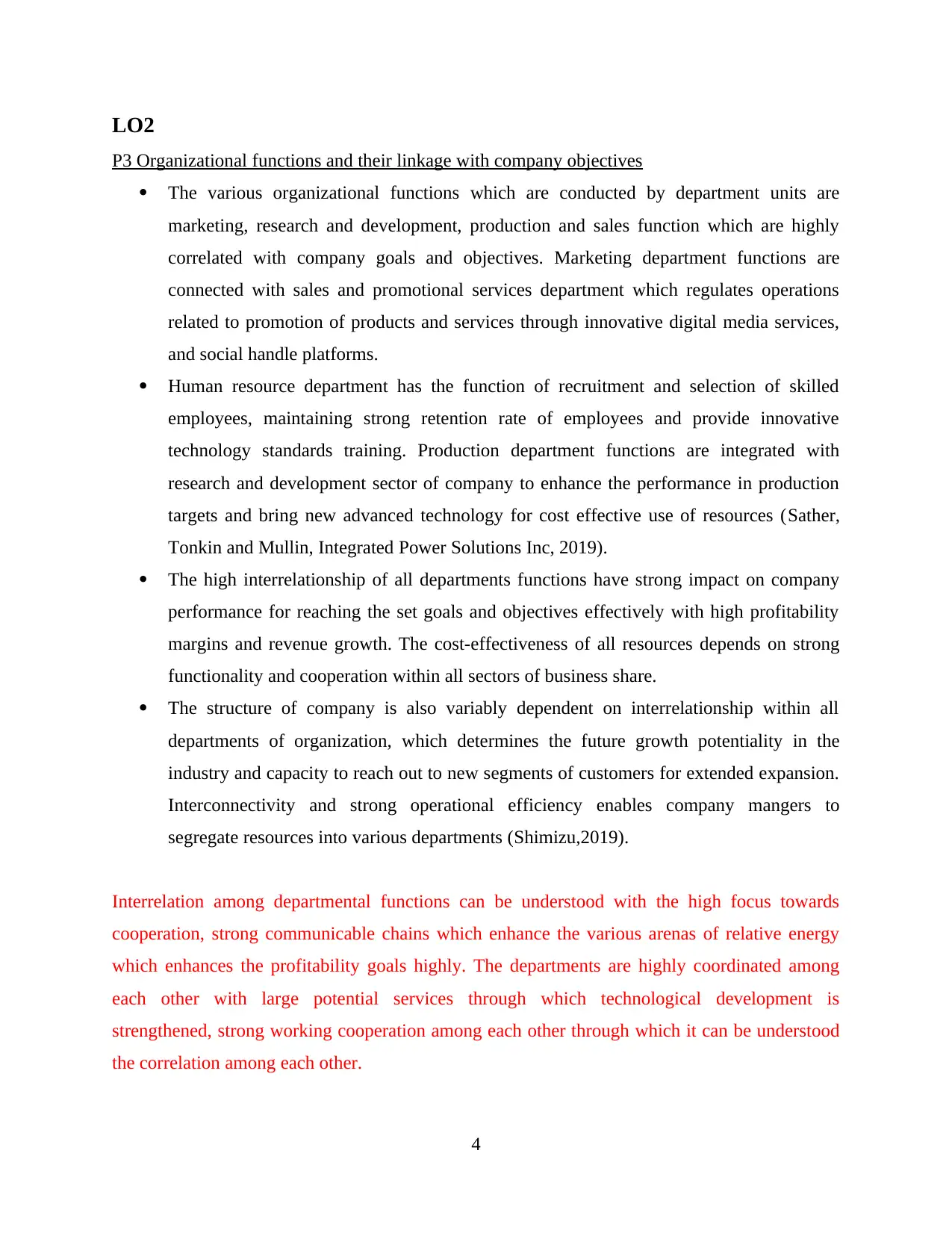
LO2
P3 Organizational functions and their linkage with company objectives
The various organizational functions which are conducted by department units are
marketing, research and development, production and sales function which are highly
correlated with company goals and objectives. Marketing department functions are
connected with sales and promotional services department which regulates operations
related to promotion of products and services through innovative digital media services,
and social handle platforms.
Human resource department has the function of recruitment and selection of skilled
employees, maintaining strong retention rate of employees and provide innovative
technology standards training. Production department functions are integrated with
research and development sector of company to enhance the performance in production
targets and bring new advanced technology for cost effective use of resources (Sather,
Tonkin and Mullin, Integrated Power Solutions Inc, 2019).
The high interrelationship of all departments functions have strong impact on company
performance for reaching the set goals and objectives effectively with high profitability
margins and revenue growth. The cost-effectiveness of all resources depends on strong
functionality and cooperation within all sectors of business share.
The structure of company is also variably dependent on interrelationship within all
departments of organization, which determines the future growth potentiality in the
industry and capacity to reach out to new segments of customers for extended expansion.
Interconnectivity and strong operational efficiency enables company mangers to
segregate resources into various departments (Shimizu,2019).
Interrelation among departmental functions can be understood with the high focus towards
cooperation, strong communicable chains which enhance the various arenas of relative energy
which enhances the profitability goals highly. The departments are highly coordinated among
each other with large potential services through which technological development is
strengthened, strong working cooperation among each other through which it can be understood
the correlation among each other.
4
P3 Organizational functions and their linkage with company objectives
The various organizational functions which are conducted by department units are
marketing, research and development, production and sales function which are highly
correlated with company goals and objectives. Marketing department functions are
connected with sales and promotional services department which regulates operations
related to promotion of products and services through innovative digital media services,
and social handle platforms.
Human resource department has the function of recruitment and selection of skilled
employees, maintaining strong retention rate of employees and provide innovative
technology standards training. Production department functions are integrated with
research and development sector of company to enhance the performance in production
targets and bring new advanced technology for cost effective use of resources (Sather,
Tonkin and Mullin, Integrated Power Solutions Inc, 2019).
The high interrelationship of all departments functions have strong impact on company
performance for reaching the set goals and objectives effectively with high profitability
margins and revenue growth. The cost-effectiveness of all resources depends on strong
functionality and cooperation within all sectors of business share.
The structure of company is also variably dependent on interrelationship within all
departments of organization, which determines the future growth potentiality in the
industry and capacity to reach out to new segments of customers for extended expansion.
Interconnectivity and strong operational efficiency enables company mangers to
segregate resources into various departments (Shimizu,2019).
Interrelation among departmental functions can be understood with the high focus towards
cooperation, strong communicable chains which enhance the various arenas of relative energy
which enhances the profitability goals highly. The departments are highly coordinated among
each other with large potential services through which technological development is
strengthened, strong working cooperation among each other through which it can be understood
the correlation among each other.
4
⊘ This is a preview!⊘
Do you want full access?
Subscribe today to unlock all pages.

Trusted by 1+ million students worldwide
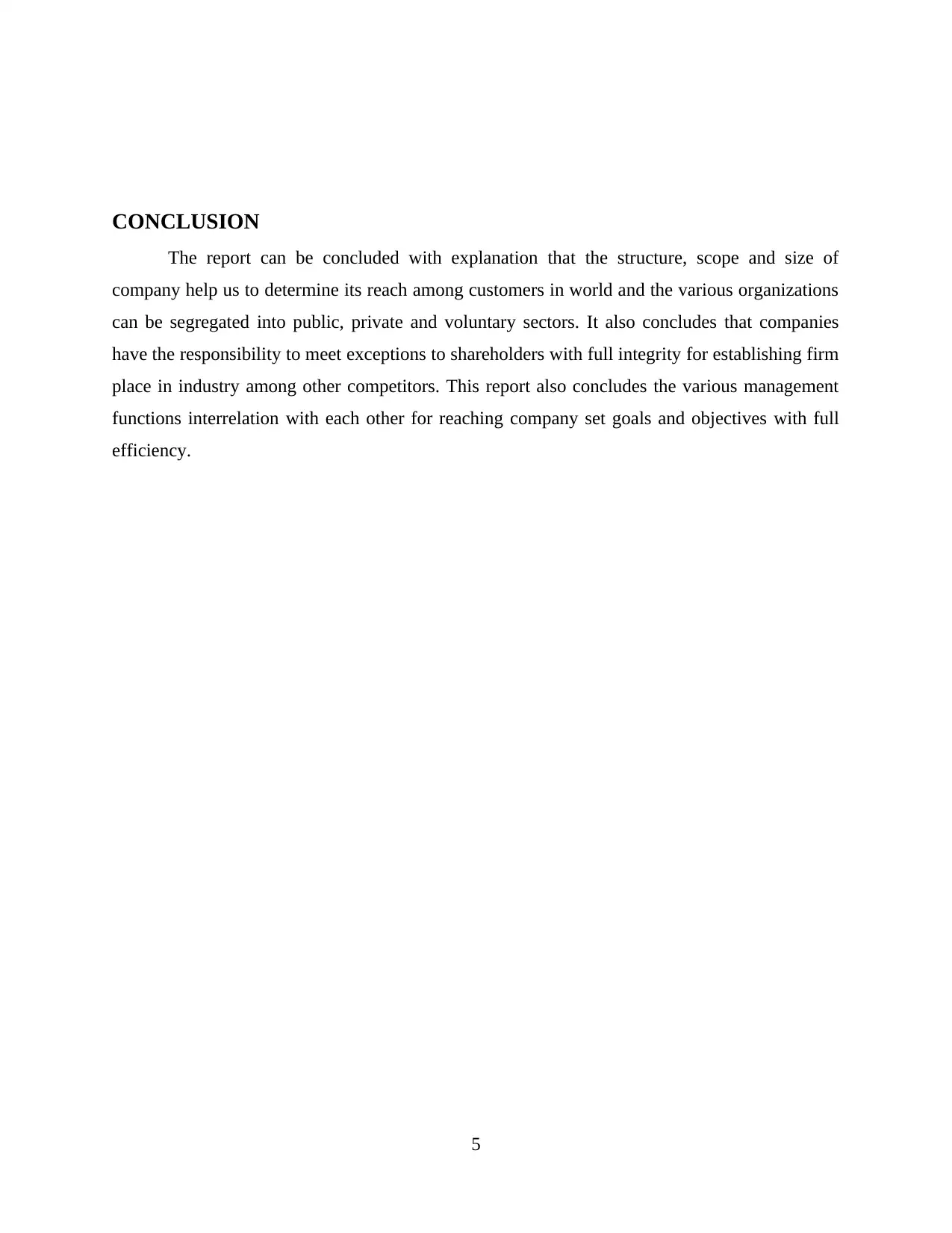
CONCLUSION
The report can be concluded with explanation that the structure, scope and size of
company help us to determine its reach among customers in world and the various organizations
can be segregated into public, private and voluntary sectors. It also concludes that companies
have the responsibility to meet exceptions to shareholders with full integrity for establishing firm
place in industry among other competitors. This report also concludes the various management
functions interrelation with each other for reaching company set goals and objectives with full
efficiency.
5
The report can be concluded with explanation that the structure, scope and size of
company help us to determine its reach among customers in world and the various organizations
can be segregated into public, private and voluntary sectors. It also concludes that companies
have the responsibility to meet exceptions to shareholders with full integrity for establishing firm
place in industry among other competitors. This report also concludes the various management
functions interrelation with each other for reaching company set goals and objectives with full
efficiency.
5
Paraphrase This Document
Need a fresh take? Get an instant paraphrase of this document with our AI Paraphraser
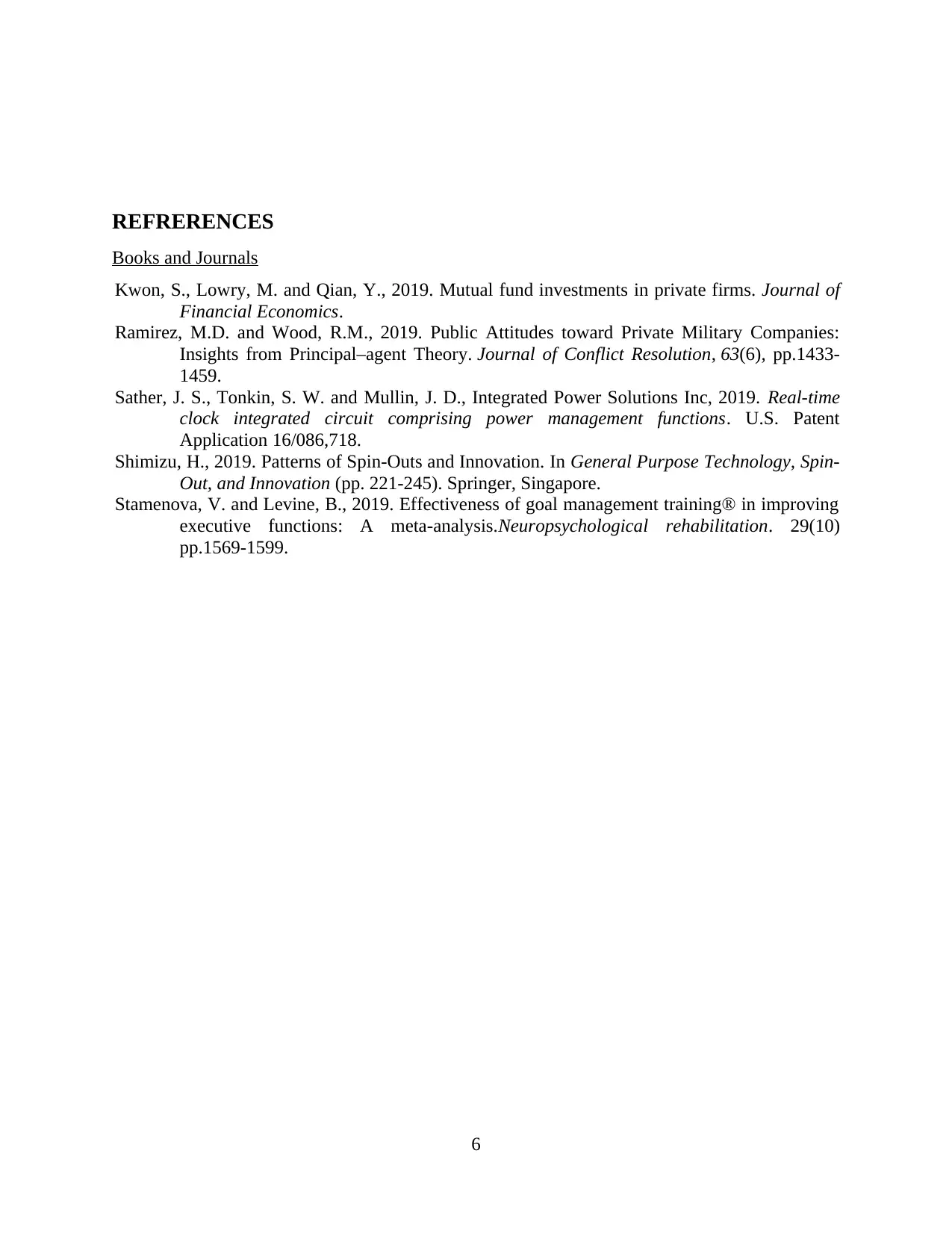
REFRERENCES
Books and Journals
Kwon, S., Lowry, M. and Qian, Y., 2019. Mutual fund investments in private firms. Journal of
Financial Economics.
Ramirez, M.D. and Wood, R.M., 2019. Public Attitudes toward Private Military Companies:
Insights from Principal–agent Theory. Journal of Conflict Resolution, 63(6), pp.1433-
1459.
Sather, J. S., Tonkin, S. W. and Mullin, J. D., Integrated Power Solutions Inc, 2019. Real-time
clock integrated circuit comprising power management functions. U.S. Patent
Application 16/086,718.
Shimizu, H., 2019. Patterns of Spin-Outs and Innovation. In General Purpose Technology, Spin-
Out, and Innovation (pp. 221-245). Springer, Singapore.
Stamenova, V. and Levine, B., 2019. Effectiveness of goal management training® in improving
executive functions: A meta-analysis.Neuropsychological rehabilitation. 29(10)
pp.1569-1599.
6
Books and Journals
Kwon, S., Lowry, M. and Qian, Y., 2019. Mutual fund investments in private firms. Journal of
Financial Economics.
Ramirez, M.D. and Wood, R.M., 2019. Public Attitudes toward Private Military Companies:
Insights from Principal–agent Theory. Journal of Conflict Resolution, 63(6), pp.1433-
1459.
Sather, J. S., Tonkin, S. W. and Mullin, J. D., Integrated Power Solutions Inc, 2019. Real-time
clock integrated circuit comprising power management functions. U.S. Patent
Application 16/086,718.
Shimizu, H., 2019. Patterns of Spin-Outs and Innovation. In General Purpose Technology, Spin-
Out, and Innovation (pp. 221-245). Springer, Singapore.
Stamenova, V. and Levine, B., 2019. Effectiveness of goal management training® in improving
executive functions: A meta-analysis.Neuropsychological rehabilitation. 29(10)
pp.1569-1599.
6

7
⊘ This is a preview!⊘
Do you want full access?
Subscribe today to unlock all pages.

Trusted by 1+ million students worldwide
1 out of 9
Related Documents
Your All-in-One AI-Powered Toolkit for Academic Success.
+13062052269
info@desklib.com
Available 24*7 on WhatsApp / Email
![[object Object]](/_next/static/media/star-bottom.7253800d.svg)
Unlock your academic potential
Copyright © 2020–2025 A2Z Services. All Rights Reserved. Developed and managed by ZUCOL.





